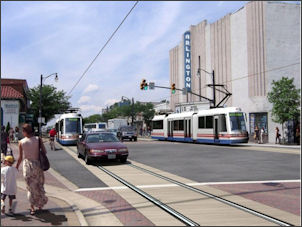 by James A. Bacon
by James A. Bacon
This is exactly what we need in the debate over Arlington’s proposed $284 million streetcar system for Columbia Pike: close scrutiny from local citizens.
Arlingtonians for Sensible Transit (AST) has issued a paper listing 15 reasons why the streetcar would be a waste of taxpayers’ money. “The consultant has collected its $100,000 fee by doing a shameless whitewash of the County Board’s desired outcome,” the paper concludes. “The losers are the County’s taxpayers who have not only paid for another worthless study, but may have to pay $310 million for a slow, uncomfortable, disruptive, hazardous, unattractive and inflexible system.”
The paper is a rejoinder to a report issued by HR&A Advisors last week that concluded a $284 million investment (in 2014 dollars, $310 million in future dollars) in a Columbia Pike streetcar system would generate significantly higher economic benefit than a far less expensive investment in an upgraded bus system. My quick-and-dirty analysis found the main conclusions to be supportable, although I suggested that if the benefits were as great as HR&A says they are, perhaps the city should finance the project by means of setting up a tax district to pay off the bonds. For property owners, the increase in leases and rents would more than offset the higher taxes.
Arlingtonians for Sensible Transit raises a number of issues that I had not considered. Some are unpersuasive but several of them give me pause. They bear a closer look.
- The reason the proposed streetcar system could carry more riders than the proposed enhanced-bus alternatives is that the streetcars would have fewer seats and more people would be forced to stand: 28 sitting and 126 standing versus 60 sitting and 34 standing. “This is pure sophistry: Take essentially the same-sized vehicles, make the vast majority stand in one, and then claim that only that vehicle can meet capacity needs.”
- While the HR&A study says the streetcars would run almost as fast as buses, AST cites a study to suggest that buses average speeds twice that of streetcars.
- HR&A argues that streetcars are needed because an upgraded bus system would be over capacity by the year 2035. “Beyond the irrationality of spending hundreds of millions now based on speculation more than 20 years in the future, the consultant completely ignores the simple solution of increasing the number of [Bus Rapid Transit] buses.”
AST also assails HR&A’s impact on leases, rents and property values in the streetcar corridor. While I am not convinced — I think property values could rise — there is no denying the uncertainty associated with any such forecasts. Even the consultants conceded in an earlier report that streetcar impacts on property values can vary widely, depending upon a number of contextual factors.
It’s difficult for open-minded citizens who don’t have time to pore through endless studies and documents to appraise the conflicting assertions and counter-arguments. And I would argue that we shouldn’t have to. There is a simple acid test: Structure the financing so that the chief beneficiaries of the improvements — property owners along the streetcar line — pay for those improvements through a special tax levy. If the property owners are willing to go along, it’s probably a good idea. If they balk, it’s probably not.
If streetcar service makes properties so much more valuable that tenants are willing to pay 10% more in leases and rents (say, $5,000 annually for a property), then a surcharge increasing the property tax (by, say, $2,500 annually) should be easy to bear. In that case, why wouldn’t the County Board want the prime beneficiaries to pay for the improvement rather than dunning taxpayers generally? If the deal cannot be structured to yield such a win-win outcome, or if property owners are reluctant to assume the risk associated with trading higher taxes (a certainty) for higher rents (speculative), that should be a warning that the risk-adjusted economic value created does not justify the investment.
Whose analysis would you trust — property owners with skin in the game, or consultants on the payroll of the streetcar advocates?
I am not saying that the streetcar project is a bad idea. The proposal could work out just fine. It’s entirely possible that the streetcars will be a hit, property values will rise, new development will occur, and tax revenues will more than cover the up-front capital costs and ongoing operating costs. But things could go wrong, too. There could be cost overruns or project delays (consider the Rail-to-Dulles project and Norfolk’s light rail). The streetcars might attract fewer riders than expected. Businesses and households may pay less of a premium to work/live on Columbia Pike than projected. The re-development of Columbia Pike may take longer than anticipated. There is no way of knowing. That’s why it’s critical to subject the proposal to a marketplace test: Would property owners voluntarily subject themselves to a tax, and would investors buy the bonds?
It strikes me that the Arlington Board has simply made up its mind and wants to forge ahead with the project regardless. It’s always easier to take risks with other peoples’ money than with your own.


